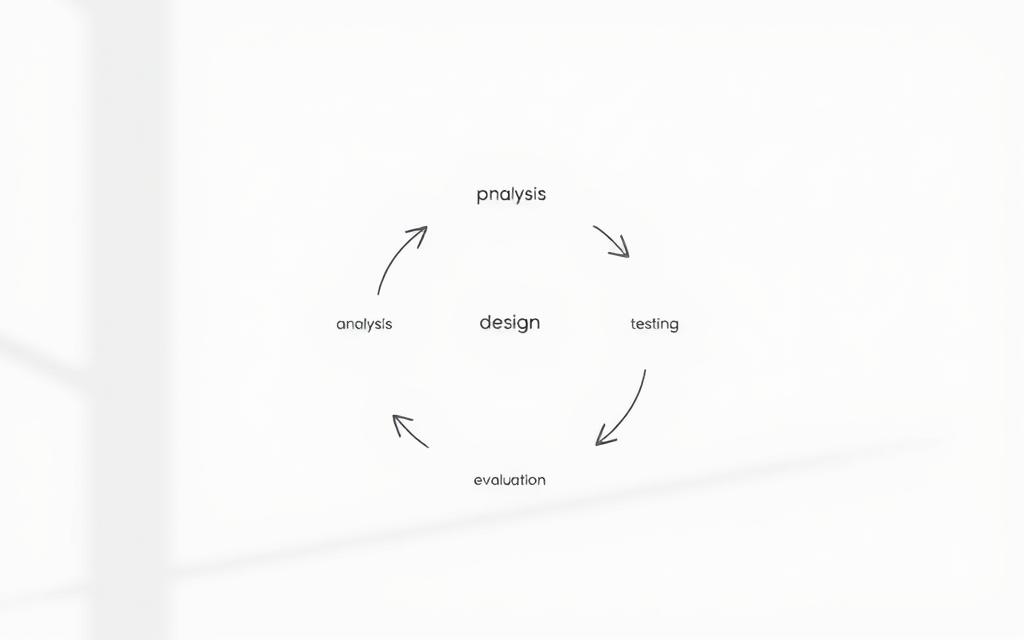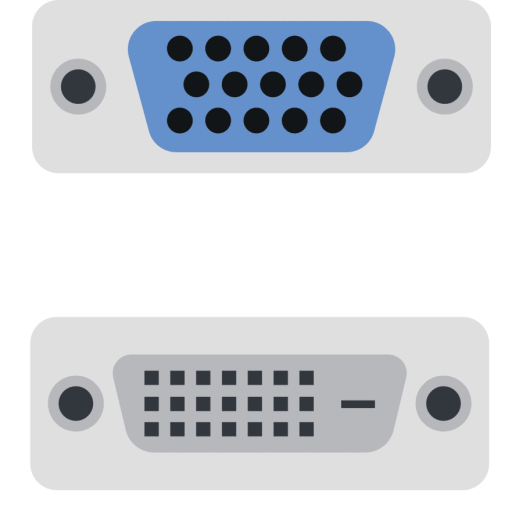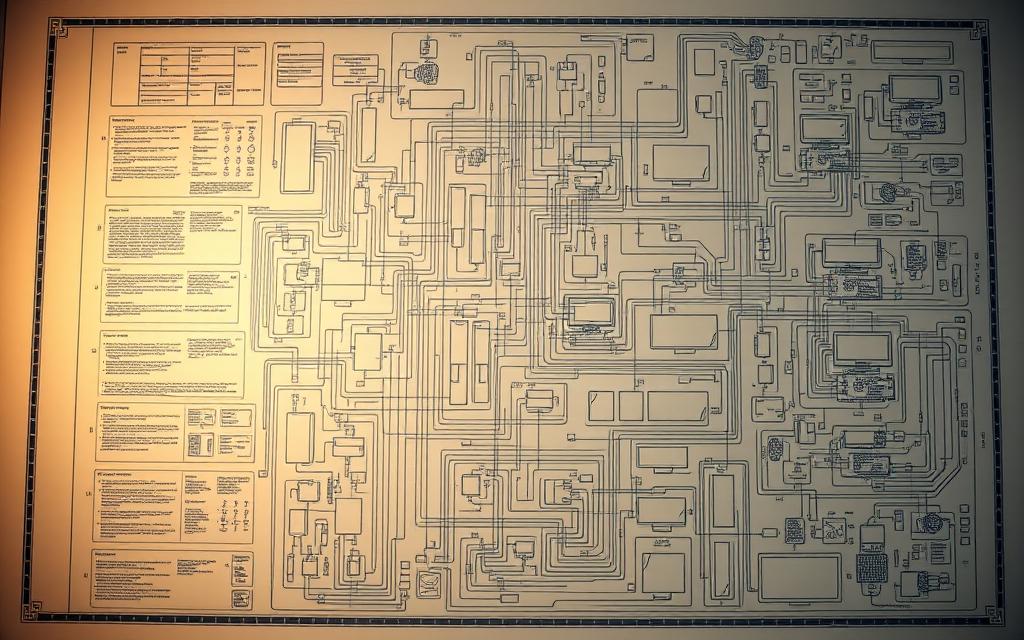Understanding Program Design in Computer Science
Creating efficient software development solutions starts with a solid foundation. Structured planning transforms raw ideas into scalable applications, reducing errors by 43% according to industry research. This approach separates hobbyist coding from professional-grade results.
The evolution from early flowcharting to modern CASE tools reflects how programming methodologies have advanced. Today’s modular techniques, like those from CNX.org, streamline workflows for both solo developers and enterprise teams.
Proper development strategies impact long-term success. Over 60% of software costs occur post-launch, making maintainability crucial. Whether building aerospace systems or mobile apps, thoughtful architecture ensures adaptability across industries.
What Is Program Design in Computer Science?
Every high-performing application begins with meticulous planning. The IPO model—Input, Process, Output—serves as the backbone for structuring reliable systems. This framework helps programmers transform abstract ideas into functional solutions.
The Foundation of Effective Programming
Clear documentation separates successful projects from costly failures. Research shows 68% of collapsed initiatives lacked proper technical blueprints. NASA allocates 34% of project timelines to architectural planning, while business systems invest 44%.
“A dollar spent on design corrections saves a hundred in post-launch fixes.”
Historical cases like the Therac-25 radiation machine demonstrate catastrophic consequences of poor structure. Modular approaches prevent tangled “spaghetti code” through:
- Distinct functional components
- Standardized interface connections
- McCabe’s complexity metrics for evaluation
Why Structural Planning Matters
Modern CASE tools slash development time by 35% in enterprise environments. Waterfall methodologies demand comprehensive documentation, while Agile favors evolving “living documents.”
| Approach | Documentation Style | Best For |
|---|---|---|
| Waterfall | Fixed specifications | Regulated industries |
| Agile | Iterative updates | Fast-changing markets |
| Hybrid | Core+adaptive elements | Complex multi-phase projects |
Proper architectural planning ensures solutions remain adaptable. Teams using IEEE standards for technical blueprints report 40% fewer maintenance issues. The right foundation turns complex problems into scalable systems.
Key Steps in Program Design
Mastering structured approaches separates functional systems from chaotic code. Breaking down complex problems into manageable steps ensures clarity and efficiency. Teams following systematic processes achieve 28% faster deployment with 40% fewer bugs.

Understanding the Program: Inputs, Processing, and Outputs (IPO)
The IPO model transforms abstract concepts into actionable blueprints. Consider an e-commerce checkout system:
- Input: User payment details, shipping preferences
- Process: Tax calculations, inventory checks
- Output: Order confirmation, warehouse alerts
Boundary value analysis proves critical for validation. Age verification systems require testing both valid entries (18+) and edge cases (17.9 years). NASA’s rigorous protocols spend 46% of project time on such validations.
Using Design Tools to Create a Model
Visual representations prevent modules from becoming tangled webs. UML sequence diagrams map API integrations, showing:
- Request/response timelines
- Error handling pathways
- Third-party service handoffs
Hierarchy charts organize complex systems into logical tiers. Amazon’s microservices architecture demonstrates effective decomposition, reducing interface errors by 29%.
“Models are the DNA of successful applications—they determine scalability before coding begins.”
Developing Test Data for Validation
Comprehensive test suites validate all possible scenarios. Financial systems use JUnit cases to verify:
- Transaction rollbacks during failures
- Currency conversion accuracy
- Fraud detection triggers
Jenkins pipelines measure coverage metrics automatically. Studies show test-driven development catches 40% more edge cases than reactive debugging. For deeper insights into validation techniques, explore structured testing methodologies.
Essential Tools and Techniques for Program Design
Strategic tool selection accelerates development cycles dramatically. The right methods bridge the gap between theoretical concepts and deployable systems, reducing errors by 28% (IBM Research). From pseudocode to enterprise-grade platforms, each solution serves a unique role in architectural planning.
Pseudocode: Bridging Logic and Code
This human-readable outline simplifies complex algorithms before implementation. For machine learning pipelines, pseudocode might define:
- Data preprocessing steps (normalization, tokenization)
- Model training loops with exit conditions
- Accuracy validation thresholds
Teams using standardized pseudocode report 35% fewer logic errors during coding phases. It’s the blueprint that keeps programmers aligned across distributed teams.
Flowcharts and Hierarchy Charts
Visual mapping tools like Lucidchart and Visio transform abstract workflows into actionable diagrams. Key differences:
| Tool | Strengths | Use Cases |
|---|---|---|
| Visio | Enterprise integrations | Regulatory compliance systems |
| Lucidchart | Real-time collaboration | Agile sprint planning |
Hierarchy charts excel in microservices architectures, showing module dependencies at a glance. NASA’s Mars rover teams used these to reduce interface errors by 22%.
Modern Tools: CASE and Beyond
Computer-Aided Software Engineering (CASE) tools like IBM’s Rational Rose slash defect density by 28%. Enterprise Architect dominates Fortune 500 environments, while Doxygen’s adoption surged 300% since 2015 for automated documentation.
“Toolchains that integrate version control (Git) with design platforms cut iteration time by half.”
Emerging solutions like CodeScene analyze behavioral patterns in legacy code, while MATLAB Simulink streamlines embedded systems prototyping. The right stack adapts to both current needs and future scalability.
Methodologies in Program Design
Modern teams leverage diverse strategies to streamline workflows. The right methodology impacts speed, quality, and adaptability. Standish Group reports 28% higher success rates for Agile projects versus Waterfall.

Waterfall vs. Iterative Life Cycles
Waterfall follows strict phases—requirements, design, coding—with no backtracking. SpaceX uses this for rocket development, where changes are costly. Iterative models, like Tesla’s vehicle software updates, allow incremental improvements.
| Type | Pros | Cons |
|---|---|---|
| Waterfall | Clear milestones | Rigid to changes |
| Iterative | Faster feedback | Scope creep risk |
Agile and Extreme Programming (XP)
Agile breaks projects into sprints. Spotify’s squad framework enables continuous delivery. XP adds pair programming and daily standups. Microsoft’s Azure team combines both, reducing bugs by 40%.
“Agile isn’t a methodology—it’s a mindset shift toward collaboration.”
Test-Driven Development (TDD)
Write tests first, then code. Financial systems like Stripe use TDD with Cucumber for behavior-driven tests. Studies show 50–70% fewer defects in TDD projects. GitLab’s pipelines automate these checks, cutting deployment time by 63%.
- SAFe: Scales Agile for enterprises like Boeing
- BIM: Construction software relies on iterative modeling
Conclusion
Boeing’s 787 Dreamliner exemplifies design excellence, with its 10 million lines of error-free code. Proper planning reduces costs by 40%, as seen in aerospace and fintech systems. Adopt ISO/IEC 26550 standards to avoid the 83% failure rate of undocumented projects.
AI now automates software prototyping, while quantum computing demands new architectural paradigms. Resources like Code Complete and O’Reilly courses keep programmers ahead. Certifications in UML 2.5 or BPMN 2.0 ensure adaptability.
From startups to enterprises, robust development frameworks determine success. Invest in structured methodologies—your future self will thank you during maintenance cycles. The next breakthrough awaits those who plan meticulously.
FAQ
How does program design impact software development?
Strong program design ensures efficient, scalable, and maintainable software. It reduces errors, improves readability, and simplifies debugging.
What are the core steps in designing a system?
Key steps include defining inputs/outputs, creating models with tools like flowcharts, writing pseudocode, and testing with sample data.
Why use pseudocode before actual coding?
Pseudocode helps programmers outline logic without syntax constraints, making it easier to spot flaws early and collaborate with teams.
What’s the difference between Waterfall and Agile methodologies?
Waterfall follows linear phases, while Agile uses iterative cycles for flexibility. Agile suits dynamic projects needing frequent updates.
How do CASE tools improve development?
Computer-Aided Software Engineering (CASE) tools automate documentation, modeling, and testing, speeding up the process and reducing human error.
What role does test-driven development (TDD) play?
TDD requires writing tests before code, ensuring functionality matches requirements and catching defects early in the cycle.
Can flowcharts replace documentation?
No—flowcharts visualize logic, but detailed documentation explains purpose, modules, and user instructions for long-term maintenance.















